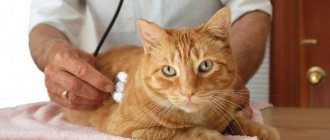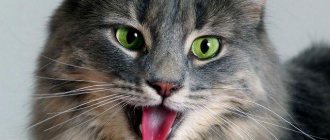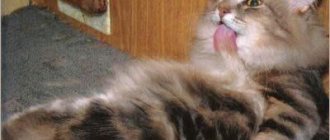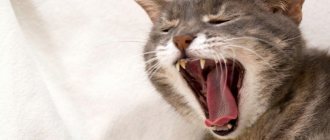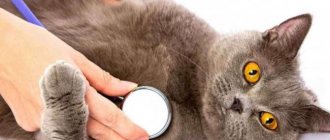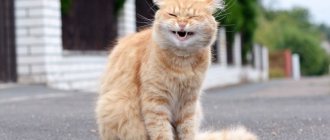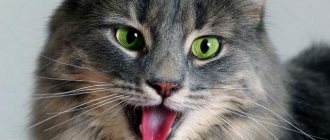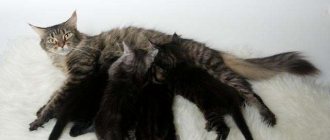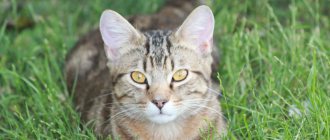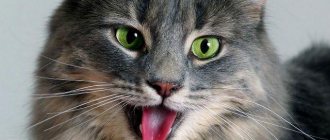13591Administration
If the cat is breathing heavily and wheezing, then this indicates a serious illness. It is necessary to pay attention to the characteristics of the symptoms. For example, when a cat breathes normally, the animal's chest rises and falls. In this case, the process occurs calmly, without jerks or convulsive movements.
However, if the cat begins to breathe from the stomach and sides, this means a disruption in the functioning of the respiratory tract. It is painful for the animal to exhale and inhale, as it does in a normal state. An even more alarming syndrome is when wheezing is added to the symptoms listed above.
© shutterstock
Causes of wheezing with heavy breathing
This is noisy bubbling breathing. It can occasionally be caused by a cold, and also accompanies most diseases of the respiratory system. A cat often wheezes for the following reasons :
- foaming of accumulated liquid (blood, trans- or exudate);
- the gaps in the respiratory tract narrow.
When the animal loses its voice, it wheezes for a long time. This indicates a violation of the vocal cords, their incomplete closure. The animal will wheeze until they are fully recovered. This phenomenon occurs when mucous fluid accumulates in crevices or with laryngitis.
Changes in a cat's breathing may be a consequence of obesity. In this case, even after little physical activity the animal breathes heavily. Sudden wheezing may indicate that the cat has swallowed a foreign body that is stuck in the throat. You can't try to pull it out on your own. Why can't pet owners do this? Without qualified help, the object can be pushed even further and the animal will die.
Symptoms and diagnosis
Depending on the causes of the disease. In addition to cough, the following additional symptoms develop:
- dyspnea;
- refusal to eat;
- salivation;
- elevated temperature.
The veterinarian examines the animal, identifies clinical symptoms, collects anamnesis, and takes blood samples for general analysis and biochemistry. If necessary, additional diagnostic studies are carried out:
- stool analysis;
- study of tracheal washings;
- X-ray of the chest cavity.
The doctor deciphers the research results and develops a treatment strategy.
Types of wheezing
Wheezing is a combination of sounds and noises. Each disease has its own variants. Wheezing can be :
- with a whistle;
- wet;
- crepitant;
- dry.
© shutterstock
If moist wheezing is heard, the cat is suffering from mucus accumulated in the bronchi. Sputum is formed in large quantities against the background of inflammation and colds that affect the broncho-tree. The inhaled air seeps through the mucus in the form of bubbles, which then burst. As a result, the cat wheezes when he breathes. This combination of sounds refers to the wet version. In this case, wheezing has several varieties :
- Fine bubbles, when small balloons formed by phlegm collapse. They appear with bronchitis, pneumonia and pulmonary infarction.
- Medium bubbly - like the sound of air being blown through a straw. Such wheezing appears during bronchitis, accompanied by excessive mucus production, pneumosclerosis, or pulmonary fibrotic changes.
- Large bubbles can be heard without a medical device. Wheezing appears due to the accumulation of exudate in the lungs. This occurs due to swelling of the organ or with a weak cough.
Dry, heavy breathing with wheezing may be the result of obstruction due to narrowing of the bronchi. Also, the reason may be an allergic reaction or compression of the airways by a neoplasm. It is difficult for air to penetrate through narrow gaps, which creates a certain noise. Then it develops into a wheezing wheeze as it moves along the unevenly narrowed bronchi.
If they also contain viscous mucus, then membranes are created that block the path of air. As a result, breathing takes on a buzzing sound. It is very difficult for air to penetrate through the narrowed and partially covered lumen.
Prevention measures
To prevent your cat from wheezing, you need to regularly monitor his health and regularly visit the veterinarian. Timely deworming and vaccination help reduce the likelihood of difficulty breathing. In most cases, wheezing is recorded due to disorders of the respiratory tract. To prevent such diseases, you should not allow hypothermia and give your pet cold food and water. It is important to eliminate all possible allergens and monitor the animal so that it does not ingest any foreign objects. If you have difficulty breathing or other alarming symptoms, you should not self-medicate, but should immediately contact a veterinarian so that your pet does not die.
The appearance of wheezing due to illness
The causes of wheezing are divided into 2 groups. Each of them has its own characteristics. Symptoms can appear in both a kitten and an adult.
Pulmonary
The pulmonary group of causes is caused by diseases of the respiratory system. The appearance of wheezing can be a consequence of inflammation, including an allergic nature. Sometimes the airways become injured by foreign bodies accidentally entering them.
© shutterstock
In this case, they get stuck in the larynx, pharynx, bronchi or trachea. This interferes with normal breathing, it becomes heavier and more difficult. The cat begins to wheeze, sniffle and cough. Foamy fluid is discharged from the nostrils, sometimes with blood clots. The cat does not drink or eat and can easily suffocate.
ARVI or influenza is not scary for these animals; they do not get sick from them. However, viral infections may well be picked up. For example, a cat wheezes and sneezes when she gets sick :
- Rhinotracheitis, calcivirosis. Against their background, the animal appears to be breathing heavily. Both diseases are viral and are very dangerous for cats. Pathologies affect the mucous surfaces of the intestines and respiratory system. At the same time, this is accompanied by diarrhea (sometimes with severe dehydration), cough, high fever and wheezing. With rhinotracheitis, additional purulent mucus is released from the nose and eyes, and with calcivirosis - ulcers on the tongue and mucous membranes of the eyes.
- With asthma, a cat huddles to the floor, coughs, wheezes and stretches its neck. If the disease is severe, severe shortness of breath, wheezing, and even suffocation of the animal appear. Owners confuse these symptoms, believing that the cat simply choked. However, if it is asthma, then the attacks will become more frequent. However, there is no guarantee that the animal will not suffocate without the help of a veterinarian.
- Pneumonia can have a different nature - fungal, bacterial or viral. First, the cat begins to cough violently, as if barking. It “scratches” the respiratory tract, the animal’s temperature rises, and wet wheezing sounds are heard.
- Brachycephalic syndrome is accompanied by the proliferation of palatal tissues and narrowing of the nasal passages. As a result, the cat begins to wheeze and wheeze. During sleep, the animal's mouth is constantly open. At the same time, the cat eats normally and remains active.
- With tracheal collapse, the initial stage does not bother the animal. With strong emotional outbursts, the cat begins to cough, then wheeze, and breathing becomes heavy. Often the animal even loses consciousness.
- Helmitoses are parasites. Their migration causes wheezing, similar to that heard in bronchial asthma. Most often, cats are diagnosed with dirofilariasis or aleurostrongylosis.
- Pneumo- and hydrothorax occur after rupture of the lungs. The most common cause is tumors and injuries. The cat is breathing heavily, with wheezing. The animal sits with its mouth wide open.
- Laryngospasm, swelling of the larynx, appears when a cat is poisoned by household chemicals. Also, wheezing can occur due to an allergic reaction after inhaling smoke, strong aromas, or dust. In these cases, the animal breathes with difficulty, whistling.
Light wheezing and heavy hissing can appear due to congenital pathologies - with elongation of the palate, polyps, narrowing of the nasal passages. Symptoms worsen after any physical activity.
Extrapulmonary
The extrapulmonary group of causes is caused by a disorder in the functioning of internal organs and systems that are not associated with the respiratory system. Diseases :
- Pulmonary edema is caused by various diseases of internal organs and their inflammation. At the same time, the cat breathes with great difficulty, with wheezing, the sides become very swollen, and pinkish foam appears from the nose.
- A diaphragmatic hernia is very similar in symptoms to asthma. The animal is also breathing heavily and hoarsely.
- The same symptoms are characteristic of heart failure, but in this case the animal does not cough. Myocardosis and carditis, and arrhythmia lead to disruption of the respiratory system.
© shutterstock
Often the cause of wheezing and heavy breathing is kidney failure. It leads to pulmonary edema. At the same time, the animal’s sides swell and a severe cough appears.
How to help at home?
First of all, examine the cat’s oral cavity and look into the throat:
- if the cat is breathing heavily with his mouth open, and strong wheezing, gurgling, whistling is heard in the chest, or fluid is flowing from the mouth and nose, immediately take him to a specialist. There is nothing you can do to help, and a delay may cost the animal its life;
- if the mucous membrane of the mouth and gums are too pale, with a purple or blue tint, then the cat is suffocating. If he has almost stopped breathing, you need to give him artificial respiration.
Causes leading to respiratory failure
Factors that cause open-mouth breathing may be physiological or pathological. Each type has its own characteristic features.
Physiological reasons
Physiological factors are not associated with deviations from the norm. Among these reasons are:
- Increased ambient temperature. Representatives of breeds with long hair especially suffer from heat.
- Excessive loads (running, jumping, playing, jogging).
- Nervous shock experienced in a stressful situation.
- Overweight.
- Hormonal releases that occur during sexual activity. An intensively working endocrine system of an animal is characterized by an increased need for oxygen.
- The process of childbirth.
Physiological factors act for a limited time. After eliminating the cause of hypoxia, normal breathing is restored. The cat owner should only wait a little until the situation stabilizes.
Pathology
Painful conditions, the symptom of which is an open mouth in a cat:
- Lesions of the oral cavity, including toothache, the appearance of ulcers on the mucous membrane, trauma, infection, cleft in the palate, etc.
- Infection of the respiratory tract by parasites.
- Foreign object in the respiratory organs.
- Diseases of the cardiovascular system (heart failure, heart disease, tumor, inflammation of the heart muscle).
- Diseases of the respiratory tract (larynx, bronchi, trachea, lungs), including edema, tumors, inflammation.
- Broken ribs. The damaged chest puts pressure on the lungs and prevents the cat from breathing normally.
- A head injury that affects the part of the brain responsible for regulating breathing.
- Damaged spinal cord.
- Intoxication.
- Allergic reaction.
- Stomach bloating.
- Torn diaphragm.
- Myopathy.
Some diseases from this group can lead to an acute lack of oxygen. The unfavorable development of such a situation is fraught with death. An owner who notices progressive difficulty breathing in a cat should immediately contact a veterinarian, especially if there are other signs indicating a serious condition of the pet.
Pulmonary edema is the accumulation of water in the lung tissues. The reasons for this phenomenon, associated with any heart disease, are called cardiogenic.
Other common reasons include:
- inhalation of hot air or steam;
- allergies of various origins (drug, food, respiratory);
- complications after pneumonia;
- asthma;
- disorders of the kidneys;
- intoxication with toxic vapors or food products;
- brain damage;
- electric shock;
- heat or sunstroke;
- sepsis.
The development of pulmonary edema occurs extremely quickly and requires urgent measures to be taken to prevent the death of the pet. A set of symptoms indicating this problem:
- weakness, apathy, indifference to what is happening;
- labored breathing;
- cough, shortness of breath, protruding tongue;
- pale bluish tint of the mucous membranes;
- pink spotting when coughing;
- rapid pulse, alternating with weakened and intermittent;
- cold extremities as a result of deteriorating blood supply.
The entry of fluid or air into the chest cavity is a consequence of traumatic injury to the muscles or ribs. Perforation, leading to the entry of atmospheric air into the chest cavity, makes it impossible to fully expand the lungs when inhaling. This condition is called pneumothorax. If the chest cavity fills with blood or other fluids circulating in the body, this is referred to as hydrothorax.
The cause of injury may be a fall from a height, a fight with an aggressive dog, or being hit by a car. An injured cat should be placed on its side, calmed down and taken to a doctor for examination. The veterinarian will be able to determine exactly how injured the pet is.
Shock is a dangerous condition that threatens with unpredictable consequences. As a result, your pet may develop an acute lack of oxygen. The causes may be trauma, intoxication, consequences of infection, allergies. The owner will not be able to bring the cat out of shock on his own; qualified medical assistance is needed. The process of bringing the animal back to normal may take more than one day.
A foreign object in the respiratory tract appears during play or eating. If a cat chokes while eating, the owner should closely monitor the pet. Usually pieces of food are coughed up without problems. If the cough lasts a long time and is accompanied by wheezing, this indicates that a foreign object has penetrated to a greater depth. To remove the object, you should immediately contact the clinic. Under no circumstances should you manipulate your cat on your own. Such a practice can lead to a sad outcome.
Cardiovascular diseases often manifest themselves as difficulty breathing. If a cat is breathing heavily and frequently after active play for a couple of minutes, this is not an alarming sign. If such a symptom occurs frequently and for no particular reason, you should have your pet examined by a feline cardiologist. An additional reason to suspect that a cat has heart failure is the bluish color of the tongue and lining of the mouth.
Breeds that are at risk for cardiac diseases are British, Scottish, Maine Coon, Sphynx, Cornish Rex, Oriental, Abyssinian. Genetic defects inherent in representatives of these breeds make these pets especially vulnerable.
Other pathologies that lead to difficulty breathing in cats:
- congenital or acquired problems with the spinal cord;
- benign or malignant brain tumor that suppresses the normal functioning of the respiratory center;
- infection with helminths that lay eggs inside the lungs;
- respiratory system diseases;
- congenital defects of the oral cavity.
Why is my cat breathing heavily with her mouth open?
If your cat is breathing heavily with her mouth open, it means she is very stressed or overheated. In some cases, difficulty breathing with your mouth open also indicates an underlying medical condition that you may not be aware of.
If your cat is panting with an open mouth, you should have her examined, as this may indicate the following serious conditions:
- Asthma
- Tumor
- Heart failure
- Cancer
- Lung damage and fluid accumulation around the lungs
